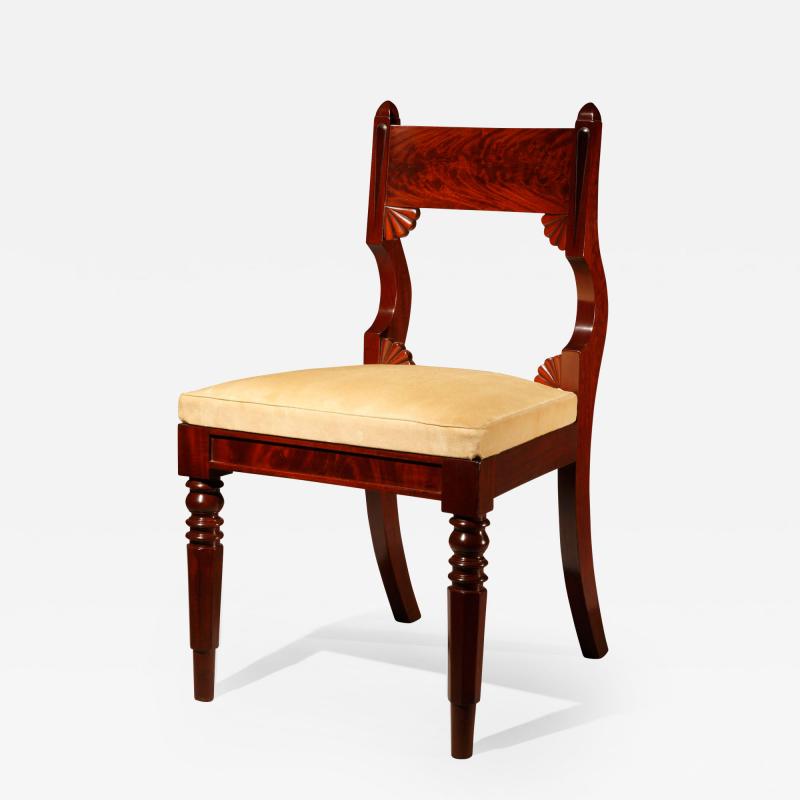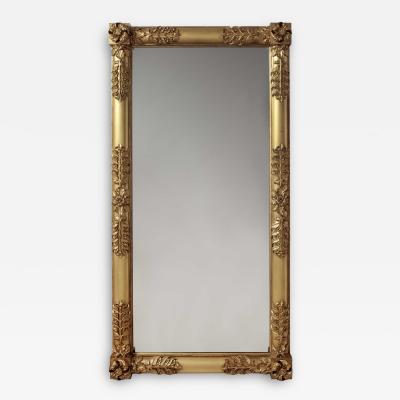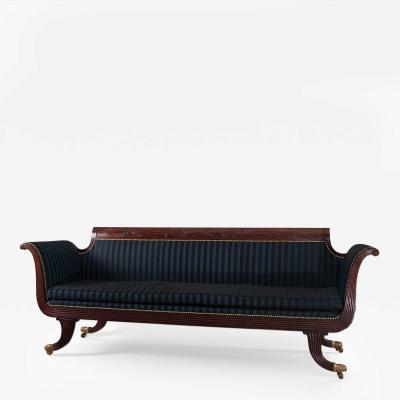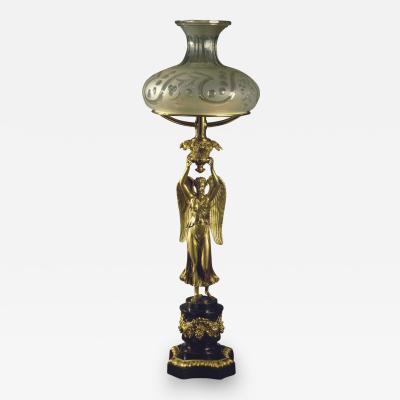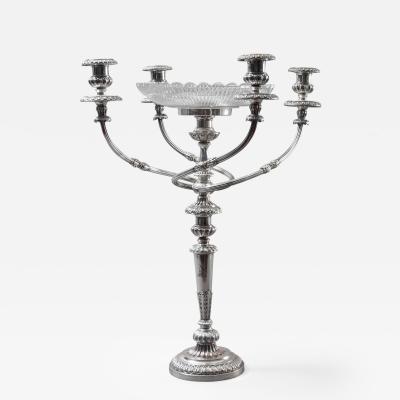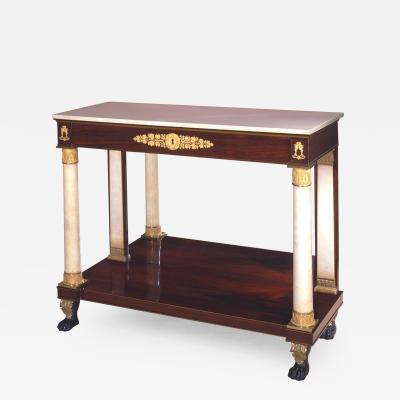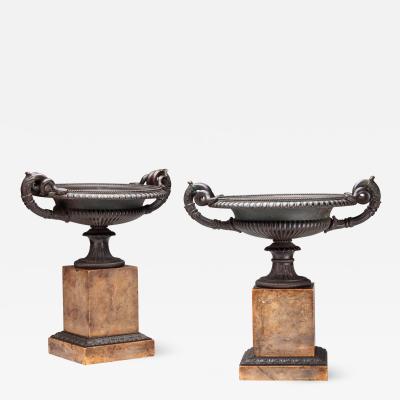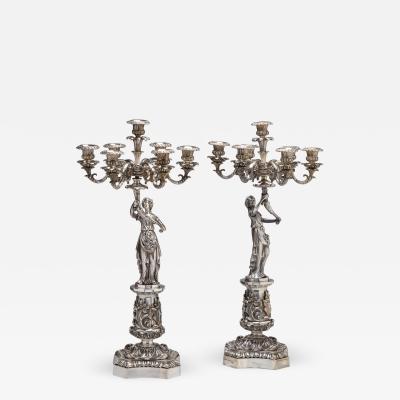Listings / Furniture / Seating / Side Chairs
Set of 12 Classical Mahogany Dining Chairs, c. 1830
-
Description
The slightly curved tablet crest rail held between incised styles with pyramidal tops and distinctively curved-back above the upholstered slip seat and continuing as saber rear legs, the paneled seat rails supported in front by turned, faceted, tapering legs. Six slip seats bear a period inscription, difficult to decipher, that looks like “G Bouvier”
Condition: Excellent; surviving in virtually perfect condition with a few small veneer patches to the crest rails, one side chair cleaned of paint with fully restored crest rail veneer and one with a mostly re-veneered rear seat rail, the arm chair pieced at the bottom of the proper right rear leg, and one with small wood replacement to the block at the top of one proper right front leg and two with chamfered front corners, recently cleaned and re-finished with shellac, in the manner of the period. The quarter-fan and “icicle” decorative elements may have originally been ebonized. The upholstery is new.
Very minor differences in the details of construction indicate that this is an assembled set although they are outwardly identical.
A small group of American-made chairs of this model are known including four in figured maple (with a pair of figured maple settees, en suite), one of these in the collection of The Brooklyn Museum, is attributed to French-born Philadelphia cabinetmaker Michel Bouvier (1791-1874), as is its mate at the Carnegie Museum of Art. A set of eight figured maple chairs with ebonized decoration are in an important private New York City collection. These sets have carved half-anthemia above the slip seats rather than the quarter-fan treatment used in the present set.
The Carnegie and Brooklyn’s attribution to Bouvier is probably based on a labeled Bouvier card table made in figured maple and the inscription on the rails of these chairs seems to support the attribution, yet any of the best known Philadelphia makers are possibilities, including: Anthony Quervelle, Charles White or Richard Parkin.
The distinctive bow or curve back of the styles of these chairs must have been inspired by plate XIX, no. 2 (a settee), and plate XXVI, no.6 (a side chair), in Thomas Hope’s enormously influential 1807 “Household Furniture and Interior Decoration” as no other English design published in the period with this feature exists. Although Hope often credited his design inspiration, he makes no mention of it in his text relating to this unique design. Hope’s Household Furniture was held by the Library Company of Philadelphia as early as 1813.
Though rare, the design was incorporated into English Regency chairs as evidenced by a circa 1815 arm chair from a set of japanned dining chairs imported to Charleston by General Thomas Pinckney (1750-1828), published in American Furniture in the article by Maurie McInnis and Robert Leath, Beautiful Specimens, Elegant Patterns: New York Furniture for the Charleston Market, 1810-1840 (Chipstone Foundation, 1996), p.140. The authors indicate that another virtually identical set were owned in Charleston by Pinckney’s brother General Charles Cotesworth Pinckney. Additionally, closely related chairs, circa 1810-15, were published in Margaret Jourdain and Ralph Fastnedge Regency Furniture (London, 1965), p.53, fig. 91 & 92. Figure 92 is also japanned like the Pinckney chairs and probably by the same maker. The authors note that these are ‘parlour’ chairs of the “Trafalgar” type, though this is because of their Klismos form with the crest held between the styles rather than the rare curved-back style treatment.
Rudolph Ackermann (1764-1834), publisher of the highly influential Repository of Arts, Literature, Commerce, Manufactures, Fashions and Politics, a monthly intelligencer published in London between 1809 and 1828, offered a drawing of a “Morning Dress” in 1819 with the model sitting on a related chair having the distinctive curved-back styles. This would support the fashionable and “most approved” status of the present model at that time. -
More Information
In the Style of: Michel Bouvier Origin: United States, Pennsylvania Period: 19th Century Materials: Mahogany. Condition: Excellent. Creation Date: United States, circa 1830. Number of Pieces: 8+ Styles / Movements: Classical, Regency, Traditional Book References: Berlin, Carswell Rush, A Shadow of a Magnitude: The Furniture of Thomas Cook & Richard Parkin, Luke Beckerdite, Ed. American Furniture (Chipstone Foundation, 2013), p. 186, fig. 54. Article References: Maurie D. McInnis and Angela D. Mack, In Pursuit of Refinement: Charlestonians Abroad 1740-1860 (Gibbes Museum of Art, 1999), p.253-4. Dealer Reference #: S-S-082231 Incollect Reference #: 104942 -
Dimensions
W. 19 in; H. 33 in; D. 20 in; W. 48.26 cm; H. 83.82 cm; D. 50.8 cm;
Message from Seller:
Welcome to Carswell Rush Berlin Antiques, a premier New York City-based dealer specializing in American antique furniture and decorative accessories from the Classical period (1800-1840). For inquiries, please contact us at 646.645.0404 or email carswellberlin@msn.com.















